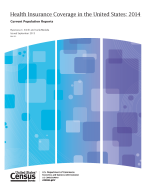Health Insurance Coverage in the United States: 2014
Health Insurance Coverage in the United States: 2014
Report Number: P60-253
Introduction
This report presents statistics on health insurance coverage in the United States based on information collected in the 2014 and 2015 Current Population Survey Annual Social and Economic Supplements (CPS ASEC) and the American Community Survey (ACS).
Highlights
- The uninsured rate decreased between 2013 and 2014 by 2.9 percentage points. In 2014, the percentage of people without health insurance coverage for the entire calendar year was 10.4 percent, or 33.0 million, lower than the rate and number of uninsured in 2013 (13.3 percent or 41.8 million).
- Between 2008 and 2013, the uninsured rate was relatively stable. In 2014, the uninsured rate sharply decreased, which was the largest change in the uninsured rate throughout this period.
- The percentage of people with health insurance coverage for all or part of 2014 was 89.6 percent, higher than the rate in 2013 (86.7 percent).
- In 2014, more people had private health insurance coverage (66.0 percent) than government coverage (36.5 percent). Of the sub-types of health insurance, employer-based insurance covered the most people (55.4 percent of the population), followed by Medicaid (19.5 percent), Medicare (16.0 percent), direct-purchase (14.6 percent), and military coverage (4.5 percent).
- Between 2013 and 2014, the increase in the percentage of the population covered by health insurance was due to an increase in the rates of both private and government coverage. The rate of private coverage increased by 1.8 percentage points to 66.0 percent in 2014 (up from 64.1 percent in 2013), and the government coverage rate increased by 2.0 percentage points to 36.5 percent (up from 34.6 percent in 2013).
- Between 2013 and 2014, the greatest changes in coverage rates were the increases in direct-purchase health insurance and Medicaid. The largest percentage-point change in coverage was for direct-purchase, which increased by 3.2 percentage points to cover 14.6 percent of people for some or all of 2014 (up from 11.4 percent in 2013). The percentage of people with Medicaid coverage during all or part of the year increased by 2.0 percentage points to 19.5 percent in 2014 (compared with 17.5 percent in 2013).
- In 2014, the percentage of uninsured children under age 19 was 6.2 percent. This was a decrease from 7.5 percent in 2013.
- In 2014, the uninsured rate for children under age 19 in poverty, 8.6 percent, was higher than the uninsured rate for children not in poverty, 5.6 percent.
- In 2014, non-Hispanic Whites had the lowest uninsured rate among race and Hispanic-origin groups, at 7.6 percent. The uninsured rates for Blacks and Asians were higher than for non-Hispanic Whites, at 11.8 percent and 9.3 percent, respectively. Hispanics had the highest uninsured rate in 2014, at 19.9 percent.
- Between 2013 and 2014, the overall rate of health insurance coverage increased for all race and Hispanic-origin groups. The increase was comparable for Blacks, Asians, and Hispanics (just over 4.0 percentage points), and lower for non-Hispanic Whites (2.1 percentage points).
- Between 2013 and 2014, every state and the District of Columbia experienced a decrease in their uninsured rate.
Tables
Visualizations
Health Insurance Historical Tables - HHI CPS (2017-2024)
Health Insurance Historical Tables - HIC ACS (2008-2024)
Health Insurance Detailed Tables
-
TableCurrent Population Survey Tables for Health Insurance CoverageThe Current Population Survey is a joint effort between the Bureau of Labor Statistics and the Census Bureau.
-
TableAmerican Community Survey Tables for Health Insurance CoverageThese tables present data on state-level health insurance coverage in the United States.
Source & Accuracy
CPS ASEC Research Files
Press Release
Related Blog
Others in Series
Publication
The Supplemental Poverty Measure: 2013
This is the fourth report describing research on the Supplemental Poverty Measure (SPM).
Publication
Income and Poverty in the United States: 2014
This report presents data on income, earnings, income inequality & poverty in the United States based on information collected in the 2015 and earlier CPS ASEC.
Publication
The Supplemental Poverty Measure: 2014
This is the fifth report describing research on the Supplemental Poverty Measure (SPM).
Page Last Revised - June 26, 2023






